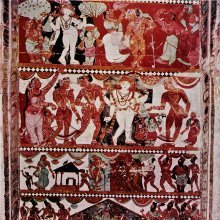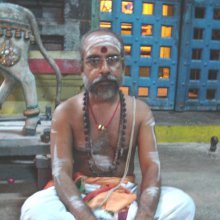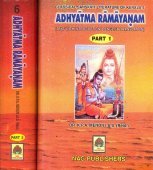Homa: 29 definitions
Introduction:
Homa means something in Buddhism, Pali, Hinduism, Sanskrit, the history of ancient India, Marathi, Jainism, Prakrit, Hindi, biology. If you want to know the exact meaning, history, etymology or English translation of this term then check out the descriptions on this page. Add your comment or reference to a book if you want to contribute to this summary article.
Alternative spellings of this word include Hom.
Images (photo gallery)
In Hinduism
Purana and Itihasa (epic history)
Source: archive.org: Puranic EncyclopediaHoma (होम).—A king belonging to the dynasty of Bharata. He was the son of Kṛśadratha and father of Sutapas. (Bhāgavata, 9th Skandha).
Source: Cologne Digital Sanskrit Dictionaries: The Purana Index1a) Homa (होम).—A Sukha god.*
- * Brahmāṇḍa-purāṇa IV. 1. 19.
1b) A mukhya gaṇa.*
- * Vāyu-purāṇa 100. 18.

The Purana (पुराण, purāṇas) refers to Sanskrit literature preserving ancient India’s vast cultural history, including historical legends, religious ceremonies, various arts and sciences. The eighteen mahapuranas total over 400,000 shlokas (metrical couplets) and date to at least several centuries BCE.
Vastushastra (architecture)
Source: McGill: The architectural theory of the MānasāraHoma (होम) refers to a sacrifice performed by the sthapati (master builder) during the ritual of “opening of the eyes”, according to Mānasāra chapter 70.—The sthapati next performs homa, sacrifice of the consecrated fire (reminiscent of the ancient Vedic fire-sacrifice), before bhuvanādhipati in the kuṇḍa, fire-pit. Rice, boiled and fried, c1arified butter, and the samid plant are offered 108 times as holocaust. Pure water is offered twenty-five times, while incanting the formula of the hṛllekhabīja, “seed-syllable that is furrowed in the heart”. This formula is constituted by the praṇava (syllable aum) at the beginning, the seed-syllable, and svāhaḥ at the end. He conc1udes the fire-sacrifice by chanting the gāyatrīmantra.
Source: OpenEdition books: Architectural terms contained in Ajitāgama and RauravāgamaHoma (होम) refers to “adjustment seat §§ 2.5, 25.”.—(For paragraphs cf. Les enseignements architecturaux de l'Ajitāgama et du Rauravāgama by Bruno Dagens)
Source: Brill: Śaivism and the Tantric Traditions (architecture)Homa (होम) refers to the “fire rite (for quelling of calamities)”, according to the Devyāmata (in the section śalyoddhāra-paṭala or “excavation of extraneous substances”).—Accordingly, “[...] If a cord is cut, there is death or deadly pain. [The officiant] who has knowledge of the ritual should perform the fire rite for quelling of calamities (śānti-homa), if he becomes aware of such [omens]. Since a levelled house brings every comfort and prosperity [to the residents], one should divide the site properly with cords and examine extraneous substances beneath the site. [...]”.

Vastushastra (वास्तुशास्त्र, vāstuśāstra) refers to the ancient Indian science (shastra) of architecture (vastu), dealing with topics such architecture, sculpture, town-building, fort building and various other constructions. Vastu also deals with the philosophy of the architectural relation with the cosmic universe.
Shaivism (Shaiva philosophy)
Source: Shodhganga: Temple management in the ĀgamasHoma (होम) or Agnikārya refers to the “fire ritual” and represents one of the various upacāras (offerings), in pūjā (ritual worship), as defined in the Śaivāgamas.—Pūjā consists of offering hospitality, in the form of water to wash the feet, to drink, water for ablutions, offering a bath, new clothes, fragrant unguents, fragrant flowers and ornaments, food and so on. Each step in the pūjā process is called “saṃskāra” and each offering is called “upacāra” [viz., Homa].
Source: Brill: Śaivism and the Tantric TraditionsHoma (होम) refers to the “performance of oblations”, according to the Kiraṇatantra chapter 49 (dealing with vratacaryā).—Accordingly, “Garuḍa spoke: ‘You have taught me, O great Lord, the activities of the Neophyte, the Putraka and the Ācārya. Tell me those of the Sādhaka’. The Lord spoke: ‘The excellent Sādhaka [should be] full of sattva, firm, capable of endurance, his mind fixed on [his] mantra, unassailable, of great wisdom, looking impartially on mud, stones and gold engaged, regular in [the performance of] oblations (homa), always devoted to recitation and meditation, dexterous in the dispelling of obstacles, firm in [the practice of his] religious observance, calm, pure. [...]’”.
Source: ORA: Amanaska (king of all yogas): (Shaivism)Homa (होम) refers to the “fire rites”, according to the Saurasaṃhitā (verse 6.7c-d).—Accordingly, “For the purpose of [performing the] fire rite (homa), one should make the sacrificial ladle a straight arm's length”.

Shaiva (शैव, śaiva) or Shaivism (śaivism) represents a tradition of Hinduism worshiping Shiva as the supreme being. Closely related to Shaktism, Shaiva literature includes a range of scriptures, including Tantras, while the root of this tradition may be traced back to the ancient Vedas.
Vaishnavism (Vaishava dharma)
Source: Pure Bhakti: Brhad BhagavatamrtamHoma (होम) refers to:—Ritual sacrificial fire. (cf. Glossary page from Śrī Bṛhad-bhāgavatāmṛta).

Vaishnava (वैष्णव, vaiṣṇava) or vaishnavism (vaiṣṇavism) represents a tradition of Hinduism worshipping Vishnu as the supreme Lord. Similar to the Shaktism and Shaivism traditions, Vaishnavism also developed as an individual movement, famous for its exposition of the dashavatara (‘ten avatars of Vishnu’).
Ganapatya (worship of Ganesha)
Source: archive.org: Shiva Purana - (Ganesha)Homa (होम) refers to a “sacrifice” (during the worship of Gaṇeśa)”, according to the Śivapurāṇa 2.4.18 (“Gaṇeśa crowned as the chief of Gaṇas”).—Accordingly, as Śiva said to Gaṇeśa: “[...] After making the eight-petalled lotus diagram on the ground in accordance with Vedic injunctions a sacrifice (homa) shall be performed by the liberal people who have no disinclination to spend money. Two women and two students shall be worshipped and fed in front of the idol duly. [...]”.
Ganapatya (गाणपत्य, gāṇapatya) represents a tradition of Hinduism where Ganesha is revered and worshipped as the prime deity (ishta-devata). Being a minor though influential movement, Ganapatya evovled, llike Shaktism and Shaivism, as a separate movement leaving behind a large body of literature.
In Buddhism
Tibetan Buddhism (Vajrayana or tantric Buddhism)
Source: De Gruyter: A Fragment of the VajrāmṛtamahātantraHoma (होम) is the name of a ritual as defined in the ‘homa-vidhi’ chapter of the 9th-century Vajrāmṛtatantra or Vajrāmṛtamahātantra: one of the main and earliest Buddhist Yoginītantras. Stanzas 25 to 39 provide several details about the homa ritual (the realization of one’s deity by means of the syllable hūṃ, the meditation on this deity, the invocation of Agni, the offering of the sacred water, etc.) and the mantras that have to be recited during its performance, i.e. the mantra of the flower, the mantra of the lamp, the mantra of the incense, the mantra of the perfume, and also the mantra for the dismissal of the deity.

Tibetan Buddhism includes schools such as Nyingma, Kadampa, Kagyu and Gelug. Their primary canon of literature is divided in two broad categories: The Kangyur, which consists of Buddha’s words, and the Tengyur, which includes commentaries from various sources. Esotericism and tantra techniques (vajrayāna) are collected indepently.
India history and geography
Source: Cologne Digital Sanskrit Dictionaries: Indian Epigraphical GlossaryHoma.—(BL; SII 3), an oblation; name of a ceremony. Note: homa is defined in the “Indian epigraphical glossary” as it can be found on ancient inscriptions commonly written in Sanskrit, Prakrit or Dravidian languages.

The history of India traces the identification of countries, villages, towns and other regions of India, as well as mythology, zoology, royal dynasties, rulers, tribes, local festivities and traditions and regional languages. Ancient India enjoyed religious freedom and encourages the path of Dharma, a concept common to Buddhism, Hinduism, and Jainism.
Biology (plants and animals)
Source: Google Books: CRC World Dictionary (Regional names)Homa in India is the name of a plant defined with Acacia catechu in various botanical sources. This page contains potential references in Ayurveda, modern medicine, and other folk traditions or local practices It has the synonym Senegalia catechu (L.f.) P.J.H. Hurter & Mabb. (among others).
Example references for further research on medicinal uses or toxicity (see latin names for full list):
· Journal of Economic and Taxonomic Botany (1996)
· Species Plantarum.
· Flora of Taiwan (1993)
· Supplementum Plantarum (1782)
· The forest flora of North-West and Central India (1874)
· London Journal of Botany (1842)
If you are looking for specific details regarding Homa, for example pregnancy safety, diet and recipes, extract dosage, chemical composition, side effects, health benefits, have a look at these references.

This sections includes definitions from the five kingdoms of living things: Animals, Plants, Fungi, Protists and Monera. It will include both the official binomial nomenclature (scientific names usually in Latin) as well as regional spellings and variants.
Languages of India and abroad
Pali-English dictionary
Source: BuddhaSasana: Concise Pali-English Dictionaryhoma : (nt.) oblation.
Source: Sutta: The Pali Text Society's Pali-English DictionaryHoma, (m. & nt.) (fr. hu, juhati) oblation D.I, 9; DA.I, 93 (lohita°). (Page 733)

Pali is the language of the Tipiṭaka, which is the sacred canon of Theravāda Buddhism and contains much of the Buddha’s speech. Closeley related to Sanskrit, both languages are used interchangeably between religions.
Marathi-English dictionary
Source: DDSA: The Molesworth Marathi and English Dictionaryhōma (होम).—m (S) Burnt-offering; the casting (of clarified butter, rice &c.) into the fire as an offering to the gods accompanied with prayers or invocations according to the object of the offering. v dē.
Source: DDSA: The Aryabhusan school dictionary, Marathi-Englishhōma (होम).—m Burnt-offering.
Marathi is an Indo-European language having over 70 million native speakers people in (predominantly) Maharashtra India. Marathi, like many other Indo-Aryan languages, evolved from early forms of Prakrit, which itself is a subset of Sanskrit, one of the most ancient languages of the world.
Sanskrit dictionary
Source: DDSA: The practical Sanskrit-English dictionaryHoma (होम).—[hu-man]
1) Offering oblations to gods by throwing ghee into the consecrated fire, (one of the five daily Yajñas, to be performed by a Brāhmaṇa, called devayajña q. v.); इष्टिर्यागः । स एवासेचनाधिको होमः (iṣṭiryāgaḥ | sa evāsecanādhiko homaḥ) ŚB. on MS.6.8.7.
2) A burnt offering.
3) A sacrifice; R.3.38; Mahābhārata (Bombay) 12.165.26.
Derivable forms: homaḥ (होमः).
Source: Cologne Digital Sanskrit Dictionaries: Shabda-Sagara Sanskrit-English DictionaryHoma (होम).—m.
(-maḥ) Burnt-offering, the casting of clarified butter, &c., into the sacred fire, as an offering to the gods, accompanied with prayers or invocations, according to the object of the sacrifice. E. hu to sacrifice, man Unadi aff.
Source: Cologne Digital Sanskrit Dictionaries: Benfey Sanskrit-English DictionaryHoma (होम).—i. e. hu + ma, m. An oblation of clarified butter, a sacrifice,
Homa (होम).—[masculine] pouring or casting into the fire; oblation, sacrifice.
Source: Cologne Digital Sanskrit Dictionaries: Monier-Williams Sanskrit-English DictionaryHoma (होम):—[from hotṛ] m. the act of making an oblation to the Devas or gods by casting clarified butter into the fire (See deva-yajña and, [Indian Wisdom, by Sir M. Monier-Williams 245]), oblation with fire, burnt-offering, any oblation or sacrifice (ayuta-h, ‘a sacrifice of 10,000 burnt-offerings to the planets’), [Atharva-veda]; etc.
Source: Cologne Digital Sanskrit Dictionaries: Yates Sanskrit-English DictionaryHoma (होम):—(maḥ) 1. m. Burnt-offering.
Source: DDSA: Paia-sadda-mahannavo; a comprehensive Prakrit Hindi dictionary (S)Homa (होम) in the Sanskrit language is related to the Prakrit word: Homa.
[Sanskrit to German]
Sanskrit, also spelled संस्कृतम् (saṃskṛtam), is an ancient language of India commonly seen as the grandmother of the Indo-European language family (even English!). Closely allied with Prakrit and Pali, Sanskrit is more exhaustive in both grammar and terms and has the most extensive collection of literature in the world, greatly surpassing its sister-languages Greek and Latin.
Hindi dictionary
Source: DDSA: A practical Hindi-English dictionaryHoma (होम) [Also spelled hom]:—(nm) a sacrifice; an oblation fire; ~[kuṃḍa] a pit for oblation fire; -[sāmagrī] the articles for putting into the oblation fire; —[karate hātha jalanā] to do a good turn and earn a bad name; —[karanā] to perform a sacrifice, to offer oblation to fire.
...
Prakrit-English dictionary
Source: DDSA: Paia-sadda-mahannavo; a comprehensive Prakrit Hindi dictionary1) Homa (होम) in the Prakrit language is related to the Sanskrit word: Homa.
2) Homa (होम) also relates to the Sanskrit word: Homa.
Prakrit is an ancient language closely associated with both Pali and Sanskrit. Jain literature is often composed in this language or sub-dialects, such as the Agamas and their commentaries which are written in Ardhamagadhi and Maharashtri Prakrit. The earliest extant texts can be dated to as early as the 4th century BCE although core portions might be older.
Kannada-English dictionary
Source: Alar: Kannada-English corpusHōma (ಹೋಮ):—
1) [noun] = ಹೋತ್ರ - [hotra -] 1.
2) [noun] the act of offering oblations to a deity in a sacrifice.
3) [noun] a living being that is sacrificed to propitiate a deity.
Kannada is a Dravidian language (as opposed to the Indo-European language family) mainly spoken in the southwestern region of India.
Nepali dictionary
Source: unoes: Nepali-English DictionaryHoma (होम):—n. a fire offering; a sacrifice;
Nepali is the primary language of the Nepalese people counting almost 20 million native speakers. The country of Nepal is situated in the Himalaya mountain range to the north of India.
See also (Relevant definitions)
Starts with (+72): Homaavarike, Homabhaksha, Homabhanda, Homabhasman, Homacarya, Homacharya, Homadarpanavidhi, Homadarvi, Homadhana, Homadhani, Homadhanya, Homadhenu, Homadhuma, Homadravya, Homadravyaparimana, Homadravyaparinama, Homadravyonmana, Homaduh, Homadvayaprayoga, Homadvayasamasaprayoga.
Ends with (+149): Abhicarahoma, Abhicharahoma, Abhihoma, Abhyatanahoma, Adhyayotsargopakarmahoma, Aggihoma, Agharajyahoma, Agnihoma, Agnihotrahoma, Agnishoma, Agrashoma, Ahoma, Ajyahoma, Amanahoma, Angahoma, Annahoma, Anuhoma, Apsushoma, Asarvahoma, Aupasanahoma.
Full-text (+453): Homakunda, Homabhasman, Darvihoma, Homam, Homadhuma, Hutahoma, Homadravya, Shantihoma, Haumya, Homavat, Tilahoma, Homabhanda, Pratarhoma, Purvahoma, Lakshahoma, Homagni, Anantavomam, Purnahoma, Narishta, Omakkini.
Relevant text
Search found 105 books and stories containing Homa, Hōma; (plurals include: Homas, Hōmas). You can also click to the full overview containing English textual excerpts. Below are direct links for the most relevant articles:
The Linga Purana (by J. L. Shastri)
Chapter 49 - Installation of Aghoreśa < [Section 2 - Pūrvabhāga]
Chapter 36 - The mode of gifting Lakṣmī < [Section 2 - Pūrvabhāga]
Chapter 52 - Rites for enslaving, fascinating etc. < [Section 2 - Pūrvabhāga]
Manusmriti with the Commentary of Medhatithi (by Ganganatha Jha)
Verse 3.86 < [Section VII - Duties of the Householder]
Verse 3.74 < [Section VII - Duties of the Householder]
Verse 11.200 < [Section XXV - Expiation for the Man excommunicated from Repasts]
Soma in Vedic Mythology and Ritual (study) (by Anjana Chakraborty)
Chapter 3(i) - The rite of ‘pressing of Soma’ (Abhisavana)
Chapter 3(j) - The Final Purificatory Bath (Avabhritha)
The Devi Bhagavata Purana (by Swami Vijñanananda)
Chapter 24 - On Sadācāra < [Book 11]
Chapter 21 - On Gāyatrī Puraścaraṇam < [Book 11]
Chapter 34 - On the methods of the worship of the Devī < [Book 5]
Mimamsa interpretation of Vedic Injunctions (Vidhi) (by Shreebas Debnath)
Chapter 4 - Viniyogavidhi (Introduction)
Chapter 4.5 - Criteria of a Difference of Rite
Chapter 4.4 - Divisions of Subsidiary Actions and Subsidiary Matters
Samarangana-sutradhara (Summary) (by D. N. Shukla)
Related products





